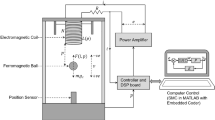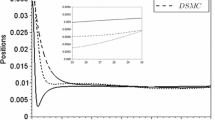Abstract
A levitation platform can be inserted into a patient’s abdominal cavity to perform diagnosis or a surgery procedure with a significantly reduced level of incision and an enhanced field of vision and operation. This paper proposes a new controller for the magnetic levitation, which connects the neural control (NC) and the sliding-mode control (SMC) serially, while the other neural sliding-mode controllers (NSMC) combine NC and SMC parallel. We call the new NSMC as two-stage neural sliding control. It has less chattering during its discrete realization and ensures finite-time convergence. Real-time experiments for a prototype of magnetic levitation in minimal invasion surgery are presented. The comparisons with other regular controllers, such as PID, NC, SMC, and normal NSMC, are made by experiment.







Similar content being viewed by others
References
Behera L, Chaudhury S, Gopal M (1996) Neuro adaptive hybrid for robot manipulator tracking control. IEE Proc Control Theory Appl 43(3):270–275
Berkelman PJ, Hollis RL (2000) Lorentz magnetic levitation for haptic interaction: device design, function, and integration with simulated environments. Int J Robot Res 9(7):644–667
Dawson D, Qu Z, Bridge M (1991) Hybrid adaptive control for the tracking of rigid-link flexible-joint robots. In: Modelling and control of compliant and rigid motion systems, 1991 ASME Winter Annual Meeting, Atlanta GA, pp 95–98
Davila J, Fridman L, Levant A (2005) Second-order sliding mode observer for mechanical systems. IEEE Trans Automat Control 50(11):1785–1789
Geim AK, Simon MD, Boamfa MI, Heflinger LO (1999) Magnet levitation at your fingertips. Nature 400:323–324
Kelly R (1998) Global positioning on robot manipulators via PD control plus a classs of nonlinear integral actions. IEEE Trans Automat Control 43(7):934–938
Khemaissa S, Moris AS (1993) Neuro adaptive control of robotic manipulator. Robotica 11:465–473
Lewis FL, Yesildirek A, Liu K (1996) Multilayer neural-net robot controller with guaranteed tracking performance. IEEE Trans Neural Netw 7(2):388–399
Lewis FL (1996) Neural network control of robot manipulators. IEEE Exp 11(2):64–75
Levant A (1998) Robust exact differentiator via sliding mode technique. Automatica 34(3):379–384
Lin F, Brandt RD (1996) An optimal control approach to robust control of robot manipulators. IEEE Trans Robot Automat 14(1):69–77
Man Z, Palaniswami M (1994) Robust tracking control for rigid robotic manipulator. IEEE Trans Automat Control 39(1):154–159
Narendra KS, Annaswamy AM (1989) Stable adaptive systems. Prentice Hall, Englewood Cliffs, p 07632
Acho AL, Orlov Y (2000) An invariance principle for discontinuous dynamic systems with application to a Coulomb friction oscillator. ASME J Dyn Syst Measure Control 122:687–690
Ortega R, Spong MW (1989) Adaptive motion control of rigid robots: a tutorial. Automatica 877–888
Rovithakis GA, Christodoulou MA (1995) Direct adaptive regulation of unknown nonlinear dynamical system via dynamical neural networks. IEEE Trans Syst Man Cybern 25:1578–1594
Zhihua Q, Dawson DM (1996) Robust tracking control of robot manipulators. IEEE Press, New York
Singh SN (1985) Adaptive model-following control of nonlinear robotic systems. IEEE Trans Automat Control 30:1099–1100
Slotine JE, Lin W (1988) Adaptive manipulator control: a case study. IEEE Trans Automat Control 33:995–1003
Willems JC (1971) Least squares optimal control and algebraic Riccati equations. IEEE Trans Automat Control 16:621–634
Yu W, Poznyak AS (1999) Indirect adaptive control via parallel dynamic neural networks. IEE Proc Control Theory Appl 146(1):25–30
Yu W, Poznyak AS, Xiaoou Li (2001) Multilayer dynamic neural networks for nonlinear system on-line identification. Int J Control 74(18):1858–1864
Author information
Authors and Affiliations
Corresponding author
Rights and permissions
About this article
Cite this article
Yu, W., Francisco, P.C. & Li, X. Two-stage neural sliding-mode control of magnetic levitation in minimal invasive surgery. Neural Comput & Applic 20, 1141–1147 (2011). https://doi.org/10.1007/s00521-010-0477-2
Received:
Accepted:
Published:
Issue Date:
DOI: https://doi.org/10.1007/s00521-010-0477-2




